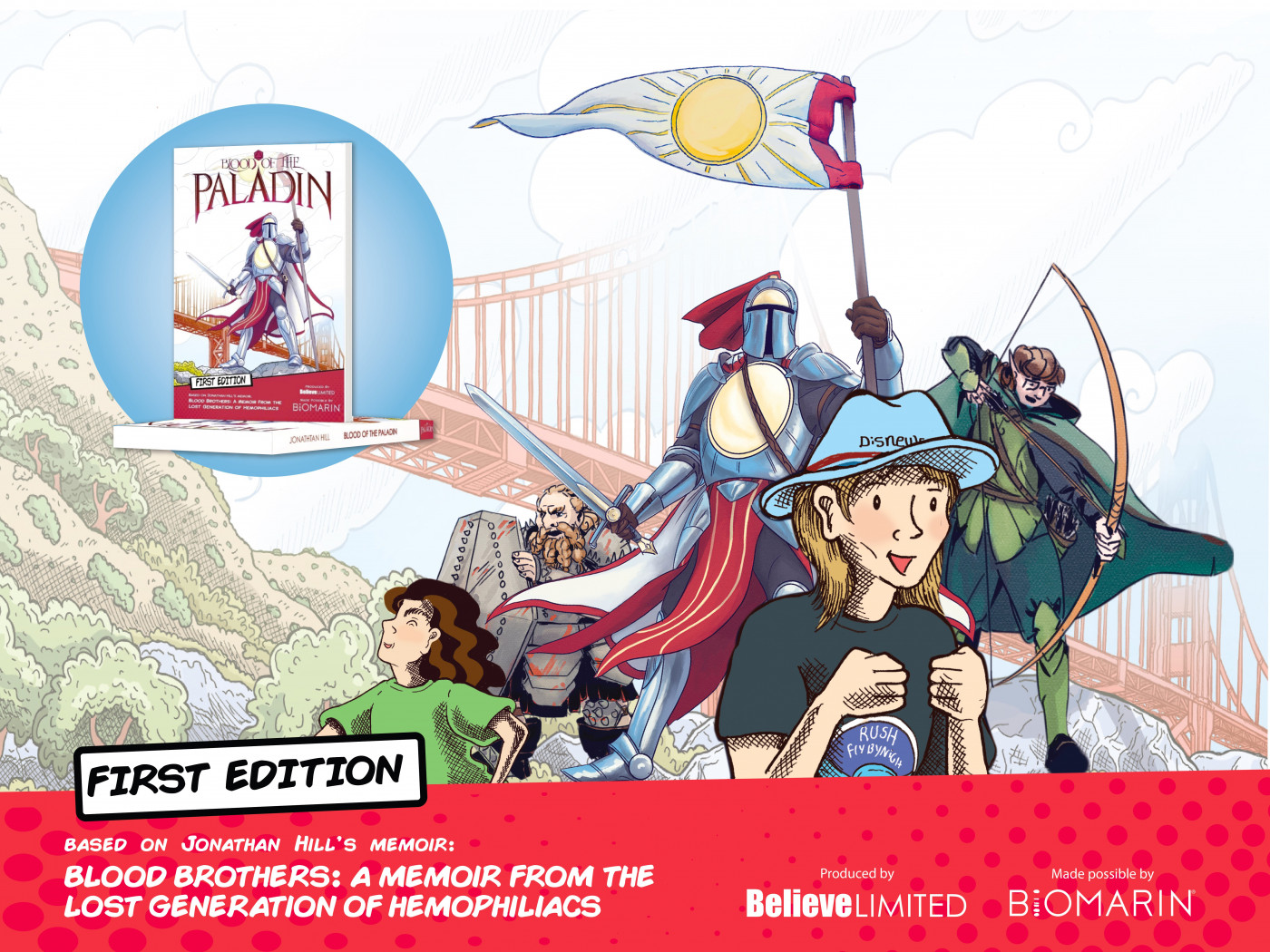Novel Illustrates Life With Hemophilia, Dungeons and Dragons

Marketing image for "Blood of the Paladin." (Photo courtesy of Believe Unlimited)
The paladin By-Tor from the Order of Light fights to protect others and always chooses life over death, even when it places him in certain danger. In the world of Dungeons and Dragons, he uses his sword and shield to impart justice.
By-Tor was created by Jonathan Hill in the real world of Novato, California, in 1982. It was his first character in the renowned role-playing game. As a teenager, he was enamored by the imagination required to succeed in the game, featured recently in the Netflix TV series “Stranger Things.”
Choosing life over death also became an important theme in Hill’s battle with severe hemophilia A since he was diagnosed with the blood disorder in 1971 at age 2. He then was diagnosed with HIV in 1984, due to a contamination of the blood supply used to treat people with hemophilia during the AIDS epidemic in the 1980s. He also was infected with hepatitis C, which made him so sick later in life that he needed a liver transplant to survive.
Dreaming up adventures for characters to embark on as the dungeon master — the person who runs the game — was how Hill, now 51, coped with extended hospital stays, pain, bleeding episodes, and the social stigma of being HIV-positive.
“I could create all these crazy scenarios like some group of Drow assassins crashing into a meeting of the adventurers as they were learning how to reset the magical portal,” said Hill, who currently works for the University of Illinois, in a Zoom interview with Hemophilia News Today. “And then the next time we got together, we could play it. So that gave me a way to just kind of just lose myself in that.”
Hill’s life story, filled with real and imagined adventures, inspired the graphic novel he recently published, “Blood of the Paladin.” It’s a story about fighting for life, Dungeons and Dragons campaigns, medical emergencies, and raising a family while facing a serious bleeding disorder.
The novel opens with a hemophilia episode in 2008 that left Hill coughing up blood, but quickly changes pace to a failed death saving throw in Dungeons and Dragons and the teen version of Hill creating his beloved By-Tor paladin character.
Hill, who has long been an advocate for hemophilia and served on both the New England Hemophilia Association and Central California Hemophilia Foundation board, was born in Lansing, Michigan, in 1969, but grew up in Novato, California, a city north of San Francisco across the Golden Gate Bridge where he and his friends played Dungeons and Dragons. The game became an escape from hemophilia.
“You’re dealing with the bleeding disorder, but you find some way to take your head out of it, so that you can move on.” said Val Bias, Hill’s former camp counselor at Camp Hemotion in Northern California, friend, past president of the National Hemophilia Foundation, and author of the novel’s foreword. “And that same coping mechanism lets you put those serious bleeds behind you. And it sort of prepares you for the next serious bleed.”
Hill’s early years at Camp Hemotion with Bias — first as a camper, then as a counselor — also were formative in his continuing battle with hemophilia. Bias, now semi-retired at 63, was adamant he keep the eight-year-old group Hill was part of in the same cabin year after year. They were like brothers, whether they liked it or not, Bias said.
“They needed to talk to somebody who had a bleeding disorder, but wasn’t necessarily directly involved with their life on a day-to-day basis,” Bais said in a joint Zoom interview with Hill.
Beyond Dungeons and Dragons, Hill shows in “Blood of the Paladin” that strong friendships were especially important to help him get through hemophilia-related challenges. Hill calls Dungeons and Dragons “communal storytelling.” As the dungeon master, Hill sets the guardrails of the story, but the players determine the outcome of the adventure.
“We’d slay monsters and kill dragons and find magical swords. There were no limits; there were no disabilities,” Hill said. “The sky was the limit on what you could do. So it got us really close.”
Around that same time, in 1984, Hill was diagnosed with HIV because of the tainted blood supply used to manufacture clotting factor VIII. The public shunned those who were HIV-positive at the time, and Hill was afraid to tell anyone about it. But seeing Ryan White, a hemophiliac also diagnosed with AIDS, fight in court to win the right to attend school inspired Hill to reveal his diagnosis to his best friend, Ian.
Hill and members of that first Dungeons and Dragons group are still friends to this day. “Blood of the Paladin” shows them growing up together, and in one instance, much later in life in 2017, some of those same friends driving him to the hospital to get a liver transplant that would save his life.
He started writing about his experience with severe hemophilia A around 2015 when he was sick with hepatitis C. It started with blogs and social media posts while he was out on disability. Hill found that people were connecting with what he wrote.
Bias and others encouraged him to continue writing, regardless of whether it would become a book. Writing was one way outside of Dungeons and Dragons that Hill could process his old life with hemophilia and his new life post-transplant, he said.
“It’s just super important to capture these stories,” Hill said. “This is my story, but there’s a lot of other people’s stories in here.”
It wasn’t Hill’s idea to turn his story into a graphic novel, but rather the idea of BioMarin, the biotech company that funded the project, and Believe Unlimited, the producer, illustrator, and editor of the novel. They felt a graphic novel with rich visuals would do the story more justice, and Believe Unlimited ended up using two illustrators: one for real-life scenes and the other for Dungeons and Dragons adventures.
The 42-page graphic novel is mostly made up of Hill’s own life experiences but is interspersed with a handful of fantasy role-playing scenes, and in some cases, the paladin By-Tor is superimposed on real-life illustrations of the Golden Gate Bridge and Washington, D.C., both places important to the story. It’s a reminder of the role By-Tor’s message of choosing life has played in helping Hill survive.
“Blood of the Paladin” is available to order for free on the website, bloodofthepaladin.com, and was shipped as part of the February edition of HemAware Magazine. Hill has been blown away by the reception so far.
One person said he put on his medical alert bracelet after reading the passage in the novel where Hill forgets his own.
Hill also sent a copy to his liver transplant doctor.
“He just kind of broke down when he was reading about all the things that I continued to go through,” Hill said. “And it gave them a lot of hope. He said, ‘I’m really glad to know that some of you are still here.’”
Even when things were looking dire, Hill said it was the Order of Light’s message of choosing life that kept him going.








